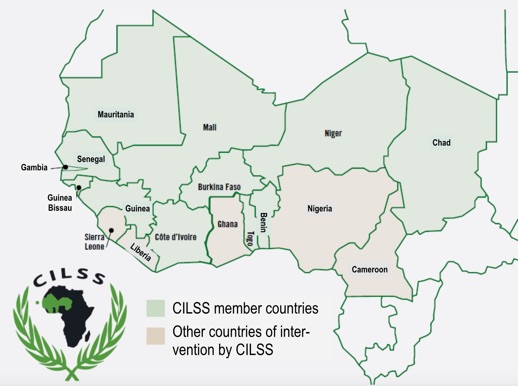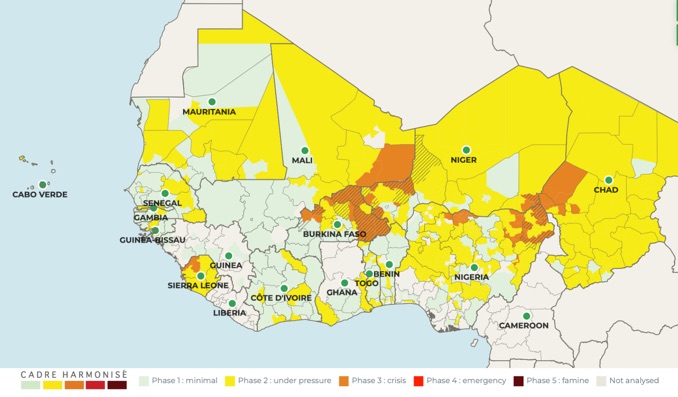News
Download pdf file: 11_01_2023_en.pdf
11 January 2024
The food situation in the Sahel is deteriorating
Gaza, Afghanistan, Yemen or Somalia are the names of countries most often mentioned by the media when they talk about ongoing acute food crises. These are crises that are mostly linked to conflict situations.
However, the difficulty to eat adequately is much more widespread in the world and it has complex causes that have already been analysed on this site [read in particular here and here].
For instance, FAO estimated, in November 2024, that 46 countries were in need of external assistance for food: 33 in Africa, 10 in Asia, 2 in Latin America and the Caribbean, and 1 in Europe [read p. 2]. On the other hand, the World Food Programme (WFP), the main UN agency in charge of emergency food assistance, was active in 120 countries [see map]
West Africa and particularly the Sahel have for decades been hit by frequent food crises with their dramatic consequences for the population.
Institutional context
This is the reason why special attention has been paid to this region. In 1973, was created the Inter-State Committee for Drought Control in the Sahel (CILSS) that groups 13 Sahelian States1 (Figure 1). In 1976, the Sahel and West Africa Club was established, whose objective is to “promote regional policies to improve the economic and social well-being of people in the Sahel and West Africa”, namely the 420 million people living in member countries of ECOWAS2, WAEMU3 and CILSS.4 The office of the Club is part of the OECD Development Cluster.
Figure 1 CILSS member countries and countries of intervention

Source: CILSS (translation by hungerexplained.org)
Following the 1982, 1983 and 1984 droughts, CILSS, the Sahel and West Africa Club (SWAC) and their partners created the Food Crisis Prevention Network (acronym in French: RPCA), whose mission is to “Promote dialogue and co-ordination, construct a coherent and consensual vision of the food and nutrition situation so as to inform decision-making.” [read in French] This “international platform for consultation and co-ordination is under the political leadership of the ECOWAS and UEMOA [WAEMU] Commissions… The SWAC/OECD Secretariat runs the Network alongside the CILSS” [read].
It appears from successive UN reports on the State of Food Security and Nutrition in the World (SOFI) that the region had seen a noticeable improvement in its food situation until recently when the trend reversed. Since 2012, we have had the opportunity to illustrate this evolution in our yearly articles on the facts and figures on world food insecurity and malnutrition [read].
Current food situation
The 39th annual meeting of the RPCA was held in Praia, Cabo Verde, from 5 to 8 December 2023. It made an update on the agro-pastoral season and analysed the food situation in the sub-region. For this, the RPCA benefits from technical means for making relatively reliable estimates of production of cereals and of the main non-cereal products. These methods and facilities were established in collaboration with partners and they operate now with resources from the sub-region.
The deliberations during the meeting showed that the food situation is both “simple and complex” according to one of the participants.
It is “simple” as the agricultural production was good, based on a forecast of 76.5 million tonnes of cereals representing a 5% increase compared to the average of the five last years. In the case of roots and tubers, who are important in the diet of the population, the estimate is that their production increased by 7% compared to the average of the five previous years. These good results follow a relatively adequate rainfall, although there were long dry spells, particularly in Mali, Mauritania, Niger, Senegal and Chad.
Meteorological conditions also allowed a rather satisfactory availability of fodder and water for livestock.
Reasons for the deterioration of the food situation
The situation is, however, “complex” because the availability of food per person is decreasing, due to a rapid population increase. It is also “complex” on the ground of the situation of insecurity prevailing in Burkina Faso, Chad, Mali, Niger and Nigeria, caused by the presence of armed jihadist and/or independentist groups and by the proliferation of economic criminality, particularly around Lake Chad (Figure 2).
Figure 2 Food situation in West Africa
(October-December 2023)

Source: RPCA
It is also “complex” because of the political situation created following a series of military coups (Mali 2021, Guinea 2021, Burkina Faso 2022 and Niger 2023) and the sanctions that were imposed on the concerned countries by the other members of ECOWAS.
Finally, it is “complex”, according to a well-informed source because “it was necessary to find a compromise to explain that in politically unstable Sahelian countries, production had dramatically fallen, without pointing at this instability as a major factor, which would have upset their governments”. This compromise, as can be easily understood, prevented the review from examining causes of the situation in a more in-depth manner.
Thus, such an analysis is sadly lacking, particularly when it is known that, despite an average production greater than what it had been during the five previous years, “The estimated number of people in a situation of food insecurity requiring serious assistance jumped from 4 million to nearly 32 million in 5 years”.
This is another illustration of the fact that, despite of what most people think, food insecurity is not simply a matter of production and availability of food, but also an issue of access by the most vulnerable sections of the population and of distribution [read].
This issue entails several interdependent dimensions [read] among which the most important, currently, for member countries of CILSS, are:
-
•Irregular rainfall patterns and heat waves resulting from climate change in a region where agriculture is mainly rainfed.
-
•Economic difficulties due, among others, to the higher prices of imported food and agricultural inputs (seeds, fertilizer and fuel) and the high prevalence of poverty.
-
•The security situation which, in addition to the victims and damage caused by armed groups, brings about loss of revenue for rural households when they cannot cultivate their usual crops or move their livestock in the search of pastures, and results in population displacement towards safer zones - often urban - where capacity to handle food insecurity is frequently lacking at national as well as regional and even international levels [read].
-
•Economic sanctions for those countries on which they are imposed and that hit most the poorest [read].
-
•Governance crisis at national as well as regional level, linked to the turbulences created by military coups.
RPCA’s conclusions
These points are broadly reflected in the conclusions of the RPCA meeting [read] that also stress, for foreign partners, the “Lack of financial resources mobilised in the face of worsening food and nutrition crises” (they have decreased compared to previous years), and put forward several good practices adopted by countries in the sub-region. Finally, they make a series of recommendations to national and regional authorities that are likely to help improve the situation in the future.

------------
Notes
-
1.CILSS members : Burkina Faso, Benin, Cabo Verde, Côte d’Ivoire, Gambia, Guinea, Guinea-Bissau, Mali, Mauritania, Niger, Senegal, Chad and Togo.
-
2.ECOWAS: Economic Community of West African States.
-
3.WAEMU: West African Economic and Monetary Union.
-
4.Benin, Burkina Faso, Cabo Verde, Côte d’Ivoire, Gambia, Ghana, Guinea, Guinea-Bissau, Liberia, Mali, Mauritania, Niger, Nigeria, Senegal, Sierra Leone, Chad and Togo.
———————
To know more:
-
•RPCA, 39th Annual Meeting - Summary of conclusions, Sahel Food Crisis Prevention Network, 2023.
-
•FAO, Crop prospects and food situation - Triannual Global Report No. 3, November 2023. Rome.
Websites :
-
•Sahel Food Crisis Prevention Network (online)
-
•Inter-State Committee for Drought Control in the Sahel (online).
Selection of past articles on hungerexplained.org related to the topic:
Last update: January 2024
For your comments and reactions: hungerexpl@gmail.com


